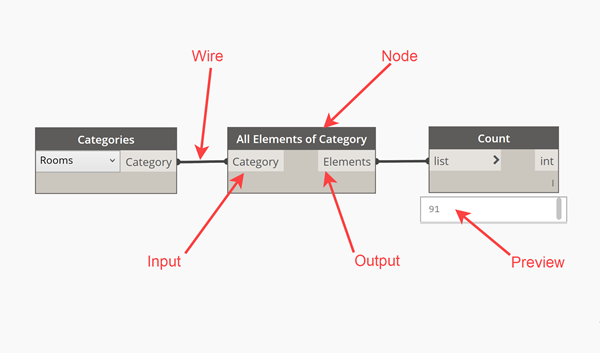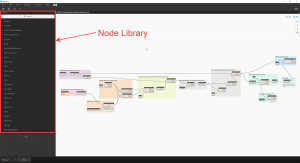Dynamo is a visual programming tool integrated with Revit. Dynamo extends Revit's capabilities by providing access to the Revit API (Application Programming Interface) in a more accessible way. Not only stopping at programming, with Dynamo users can initiate programs using graphical components called "nodes". This is a more suitable way to approach programming for visual tasks such as architecture, design, engineering, etc.

With Dynamo, each node will have a separate task. Nodes will have input and output; The output from one node will connect to the input of another node through a "wire". Programs or graphics will in turn go from node to node thanks to the wire network. The resulting product is a graphical representation of the steps required to arrive at the final design.

One of the strengths of visual programming tools like Dynamo is the ability to access a library of nodes. Instead of having to remember exactly each command for each separate request, with Dynamo we can easily search the library for the necessary nodes.

Besides, another factor contributing to Dynamo's success is the user community. Not only is there mutual support through forums, Dynamo users also create commonly used node packages and upload them to a common data environment, which is considered an online library. This online library helps users search and download directly right in Dynamo without having to visit the website or complicated settings. To install these nodes packages, users just need to click on the download button and the nodes package will be installed directly into Dynamo. The nodes packages are pre-written for each specific purpose, for example: the nodes package serves to divide and number rooms, the nodes package helps to automatically create plaster layers, or the nodes package helps automatically attach names and attributes. for components
WHY YOU SHOULD USE DYNAMO
1. Automate cyclical tasks
- Renumber the sheets
- Edit the axis mesh endpoint symbol
- Insert family
- Update changes to drawings
- Change uppercase and lowercase letters in drawings
- Once you have created the Dynamo tools above, they can be accessed directly through Dynamo Player (from Revit 2017).
2. Connect to project data
3. Explore multi-use design options
In addition to automatic design and information retrieval, Dynamo is also a tool that helps you clearly identify the steps that need to be taken in the design process as well as the principles that need to be followed during implementation.
Thanks to encoding the rules into a computational framework, Dynamo can offer hundreds, even thousands of options corresponding to those rules. In fact, Project Fractal, an Autodesk design tool, has implemented this capability of Dynamo.

However, this function of Dynamo is not limited to projects with complex shapes. You can create a tool that automatically designs rooms based on the boundaries of the walls. In fact, most accommodations are relatively similar. If you encode your business design standards into a graphic in Dynamo, you can easily calculate the total number of choices that fit the established standards. It will be more convenient to automate those boring tasks and you can spend time designing other parts of the build.
Besides, you can use Dynamo to calculate random glass patterns on a curved wall, arrange technical boxes or even arrange furniture in a regular classroom. There are many design-related applications for Dynamo. With a little research and creativity, you can master these applications.
4. Testing determines performance
How to test how your design will turn out in real life? You can wait until the project is completed or you can experiment right in the design phase, when changes can be made more easily and at less cost. Dynamo can easily simulate building performance during each design stage. You can even create a tool to estimate the number of hours of sunshine on any given day in March.

Simulation data, although not a substitute for actual data, can evaluate designs against objective standards. Simulation data will quickly evaluate which design is better to help make the most optimal choice. Design calculation tools like Dynamo provide ways to make decisions throughout the design process, not just once the project is complete.
Determining this performance is not limited to the design of buildings. Sometimes, it is necessary to evaluate the effectiveness of the model in Revit. For example, determine the change in file size over time; How many groups are contained in the model or how many views are not shown on the sheet? This information comes in handy when troubleshooting performance issues or performing quality control.
5. Think calculatedly
Dynamo requires a logical, systematic and step-by-step approach to work. Most architects depend on intuition and creativity in solving problems. This way of thinking is sometimes not suitable for processes that require calculation. But what if you could encode these intuitions? You can look at each step and really understand how it works. You can even reuse the logic in that design and improve it over time.

By using a computational process, you will be able to encode designs or workflows. Each step will consist of a sequence of instructions and can be evaluated, reviewed, and improved. Besides, each such step requires separate parameters. By thinking through all the steps of the problem and considering all inputs and outputs, you can create a process that is efficient, understandable, and most importantly, repeatable. With one less request to deal with, you can spend time on more important things!





